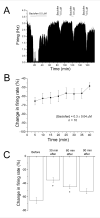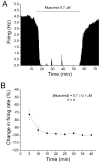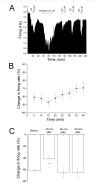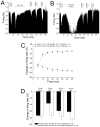Reversal of inhibition of putative dopaminergic neurons of the ventral tegmental area: interaction of GABA(B) and D2 receptors
- PMID: 22986166
- PMCID: PMC3490029
- DOI: 10.1016/j.neuroscience.2012.08.045
Reversal of inhibition of putative dopaminergic neurons of the ventral tegmental area: interaction of GABA(B) and D2 receptors
Abstract
Neurons of the ventral tegmental area (VTA) are critical in the rewarding and reinforcing properties of drugs of abuse. Desensitization of VTA neurons to moderate extracellular concentrations of dopamine (DA) is dependent on protein kinase C (PKC) and intracellular calcium levels. This desensitization is called DA inhibition reversal, as it requires concurrent activation of D2 and D1-like receptors; activation of D2 receptors alone does not result in desensitization. Activation of other G-protein-linked receptors can substitute for D1 activation. Like D2 receptors, GABA(B) receptors in the VTA are coupled to G-protein-linked potassium channels. In the present study, we examined interactions between a GABA(B) agonist, baclofen, and dopamine agonists, dopamine and quinpirole, to determine whether there was some interaction in the processes of desensitization of GABA(B) and D2 responses. Long-duration administration of baclofen alone produced reversal of the baclofen-induced inhibition indicative of desensitization, and this desensitization persisted for at least 60 min after baclofen washout. Desensitization to baclofen was dependent on PKC. Dopamine inhibition was reduced for 30 min after baclofen-induced desensitization and conversely, the magnitude of baclofen inhibition was reduced for 30 min by long-duration application of dopamine, but not quinpirole. These results indicate that D2 and GABA(B) receptors share some PKC-dependent mechanisms of receptor desensitization.
Copyright © 2012 IBRO. Published by Elsevier Ltd. All rights reserved.
Conflict of interest statement
Disclosures: None of the authors have any conflict of interest associated with the content of this report.
Figures






Similar articles
-
Dopamine D2 receptor desensitization by dopamine or corticotropin releasing factor in ventral tegmental area neurons is associated with increased glutamate release.Neuropharmacology. 2014 Jul;82:28-40. doi: 10.1016/j.neuropharm.2014.03.006. Epub 2014 Mar 19. Neuropharmacology. 2014. PMID: 24657149 Free PMC article.
-
Reversal of dopamine D2 agonist-induced inhibition of ventral tegmental area neurons by Gq-linked neurotransmitters is dependent on protein kinase C, G protein-coupled receptor kinase, and dynamin.J Pharmacol Exp Ther. 2013 Jan;344(1):253-63. doi: 10.1124/jpet.112.199844. Epub 2012 Sep 27. J Pharmacol Exp Ther. 2013. PMID: 23019137 Free PMC article.
-
Reversal of prolonged dopamine inhibition of dopaminergic neurons of the ventral tegmental area.J Pharmacol Exp Ther. 2010 May;333(2):555-63. doi: 10.1124/jpet.109.163931. Epub 2010 Feb 17. J Pharmacol Exp Ther. 2010. PMID: 20164301 Free PMC article.
-
In vivo ethanol experience increases D(2) autoinhibition in the ventral tegmental area.Neuropsychopharmacology. 2011 Apr;36(5):993-1002. doi: 10.1038/npp.2010.237. Epub 2011 Jan 19. Neuropsychopharmacology. 2011. PMID: 21248720 Free PMC article.
-
Reversal of quinpirole inhibition of ventral tegmental area neurons is linked to the phosphatidylinositol system and is induced by agonists linked to G(q).J Neurophysiol. 2012 Jul;108(1):263-74. doi: 10.1152/jn.01137.2011. Epub 2012 Apr 4. J Neurophysiol. 2012. PMID: 22490559 Free PMC article.
Cited by
-
Suppression of Gq Function Using Intra-Pipette Delivery of shRNA during Extracellular Recording in the Ventral Tegmental Area.Front Cell Neurosci. 2013 Feb 12;7:7. doi: 10.3389/fncel.2013.00007. eCollection 2013. Front Cell Neurosci. 2013. PMID: 23408114 Free PMC article.
-
A Preliminary Study of the Effects of SurAsleep on Relieving Symptoms of Sleep Disorders.Int J Biomed Sci. 2015 Jun;11(2):76-81. Int J Biomed Sci. 2015. PMID: 26199580 Free PMC article.
-
Dopamine D2 receptor desensitization by dopamine or corticotropin releasing factor in ventral tegmental area neurons is associated with increased glutamate release.Neuropharmacology. 2014 Jul;82:28-40. doi: 10.1016/j.neuropharm.2014.03.006. Epub 2014 Mar 19. Neuropharmacology. 2014. PMID: 24657149 Free PMC article.
-
Ethanol actions on the ventral tegmental area: novel potential targets on reward pathway neurons.Psychopharmacology (Berl). 2018 Jun;235(6):1711-1726. doi: 10.1007/s00213-018-4875-y. Epub 2018 Mar 16. Psychopharmacology (Berl). 2018. PMID: 29549390 Free PMC article. Review.
-
Phorbol ester reduces ethanol excitation of dopaminergic neurons of the ventral tegmental area: involvement of protein kinase C theta.Front Integr Neurosci. 2013 Dec 25;7:96. doi: 10.3389/fnint.2013.00096. eCollection 2013. Front Integr Neurosci. 2013. PMID: 24399942 Free PMC article.
References
-
- Ackerman JM, Johansen PA, Clark D, White FJ. Electrophysiological effects of putative autoreceptor-selective dopamine agonists on A10 dopamine neurons. J Pharmacol Exp Ther. 1993;265:963–970. - PubMed
-
- Arora D, Hearing M, Haluk DM, Mirkovic K, Fajardo-Serrano A, Wessendorf MW, Watanabe M, Lujan R, Wickman K. Acute cocaine exposure weakens GABA(B) receptor-dependent G-protein-gated inwardly rectifying K+ signaling in dopamine neurons of the ventral tegmental area. J Neurosci. 2011;31:12251–12257. - PMC - PubMed
-
- Bofill-Cardona E, Kudlacek O, Yang Q, Ahorn H, Freissmuth M, Nanoff C. Binding of calmodulin to the D2-dopamine receptor reduces receptor signaling by arresting the G protein activation switch. J Biol Chem. 2000;275:32672–32680. - PubMed
Publication types
MeSH terms
Substances
Grants and funding
LinkOut - more resources
Full Text Sources

